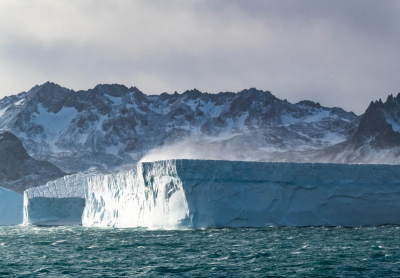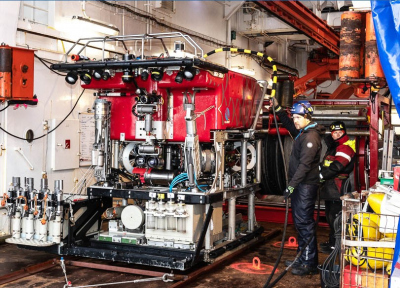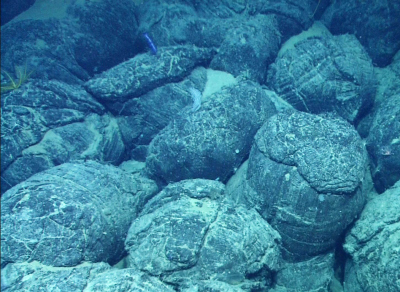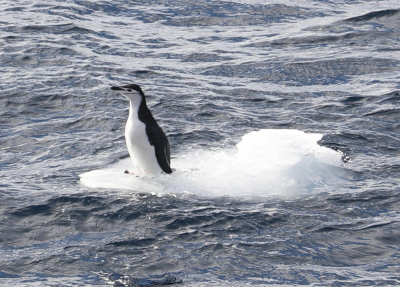- Home
- Research
- Expeditions
- 2019
- PS119
- PS119 – 3rd Weekly Report
The East Scotia Ridge – where new seafloor grows
PS119 – 3rd Weekly Report, 23. – 28.4.19
Despite not neglecting station work and the associated scientific analyses over the Easter days, we were able to celebrate Easter. At first priority stands a big thanks to the crew of RV Polarstern as they decorated the public areas and canteens to create an Easterly feeling on board. The kitchen team created further culinary advances, although this seemed impossible given the brilliant standard.
The consequences of the good food show their face at the weight watchers club on Sundays. Ultimately, also the striking looking winter-like scenery of the Drygalski Fjord contributed to an Easter that we would not experience at home. On Tuesday, 23rd April, we steamed eastwards while using acoustic survey systems and reached the East Scotia Ridge in the evening.
This N to S running ridge is created through the fracture of the seafloor by five to six centimeters each year and the resulting outflow of pillow lava. The ridge, which is characterised by a mosaic of ridge-parallel flows building a comprehensive morphological structure with at parts extremely steep slopes, separates the Scotia Plate in the West from the South Sandwich Plate in the East. Running from North to South, the ridge is split into ten segments of 30 to 90 kilometers length each (E1 to E10). On two of these segments, E2 and E9, our British colleagues had discovered active hydrothermal springs. In these areas the magma chambers lie only in two to three kilometers deep in the Earth’s crust and in fracture areas magma can rise easily and flow out on the seafloor. At the same time cold seawater penetrates the fissures and fractures of the magmatic rocks, heats up in the hot neighborhood of the magma chambers and rises again as hot fluids. At the same time this hot fluid is extremely aggressive and leaches several elements (e.g. metals) from the rocks, which when exiting the seafloor into the cold sea water form black and white smokers and create an oasis for chemosynthetic life.
On arrival at the segment E2 of the East Scotia Ridge on the evening of Tuesday, 23rd April, we started to find chemical signals of these hot springs in the water column, first with the OFOBS (Ocean Floor Observation Bathymetry System) and later by CTD and water rosette. A big help in this search were our so-called Mappers, sensors that detect next to turbidity and temperature also the redox potential. As independent recording instruments, they were deployed on almost all deployments of equipment. Our search was continued on Wednesday, 24th April, and on Thursday, 25th April, the first dive of the ROV MARUM-QUEST could happen.
We dived on a known hydrothermal vent field which had been discovered during an expedition JR224 of RRS James Clarke Ross 10 years ago. With some teething troubles we were able to recognize most of the known hydrothermal structures, but it became also clear during this dive that huge changes had happened during the past 10 years. Some of the then active black smokers were not active anymore and others showed active fluid exits that had been inactive 10 years ago. Following the assemblage structure of the chemosynthetic fauna had changed. Despite all odds we were able to collect selected target species like snails of the genus Gigantopelta and crabs of the genus Kiwa (so-called Hoff crab) for experiments in our aquaria.
During this dive we used a so-called telepresence for the first time in from a scientific Southern Ocean expedition, which technical set-up had been installed prior to this expedition by our ROV project leader Volker Ratmeyer and his team. A specialized hardware had been bought which enabled a stable satellite connecting via Polarstern’s arial dome system to upload the dive images of 5 Mbit and enabled colleagues in Bremen and elsewhere to interact online via the internet with the dive using real-time audio communication, data transfer and interactive georeferenced positioning systems.
During the second dive of QUEST on Sunday, 27th April, the public was able to follow the dive in the frame of a public screening event via the internet, with a delay of 30 minutes. We heard that this opportunity had even been used during the night in Germany, between 22:00 in the night and 4:00 in the morning. For the future we plan to make all further dives available for live viewing via the internet.
Also the second dive was a full success; in an unknown area we discovered cooling down hydrothermal vent field with mineral chimneys, built mostly of barite, gushing out of fluid temperatures of 30-50°C. About this and other discoveries we want to write in the coming weeks. All expedition participants are well.
Best wishes in the name of all cruise participants,
Gerhard Bohrmann,
RV POLARSTERN,
Monday, 28th April 2019






